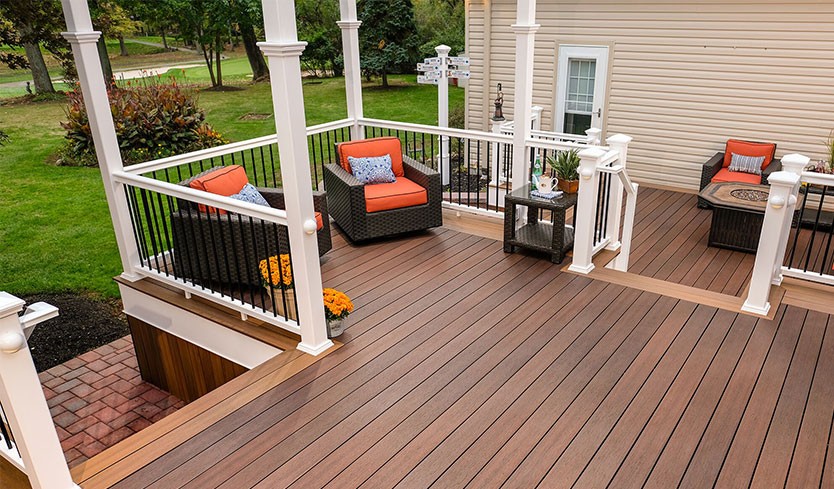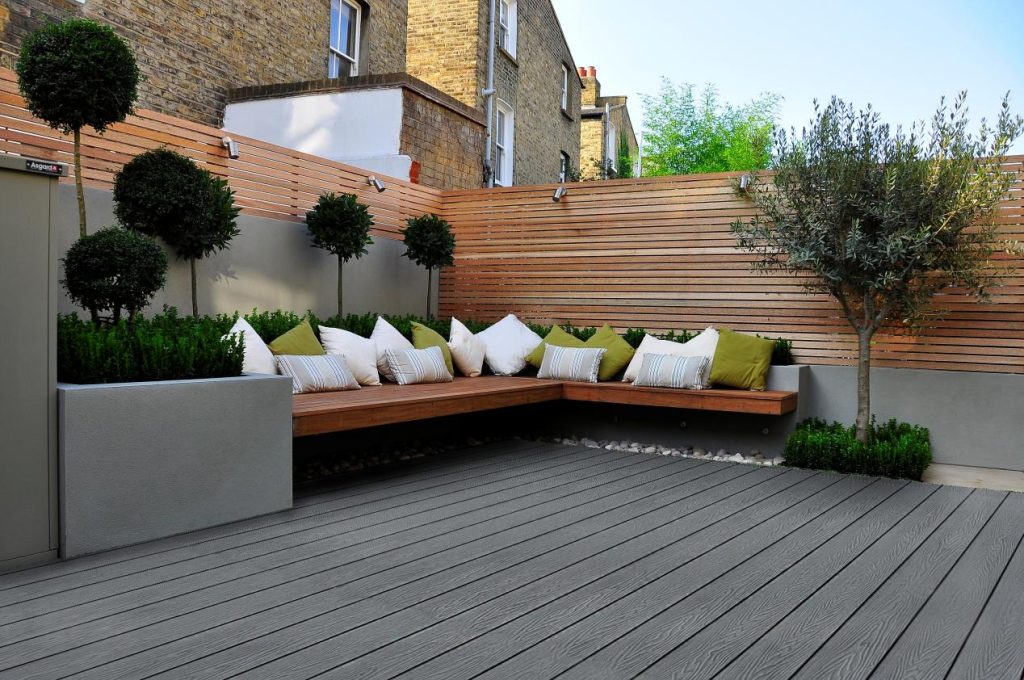With the fast-growing demands of engineering wood products for various applications, Wood-plastic composite material (commonly abbreviated as WPC), as the most important one of natural fiber-reinforced composites, has been well considered as a crucial and novel candidate for residential and industrial constructions. This article will give an overall description of the WPC material from the following 11 aspects:
- History of wood plastic composites material
- Two basic materials of WPC
- Coupling Agent For WPC
- Additives for improved performance in WPC extrusion
- Wood Plastic Composite (WPC) Manufacturing Process
- Wood-Plastic Composites Market Scope
- Advantages and Disadvantages of WPC Boards
- Maintenance of WPC floor
- The life expectancy of WPC material
- Technological breakthroughs in the WPC industry
- Wood Plastic Composite (WPC) Market Trends
History of Wood-plastic composite material
Wood polymer composites (WPCs) are a relatively recently developed product. The North American WPC market has reached almost $1 billion in sales. The current market of 320,000 t per annum (Europe, in 2020) has been developed over about 30 years of intense activity. In fact, the product can trace its roots considerably earlier. The company that invented and patented the process to create WPC was Covema of Milan in 1960. After a few years from the invention of the Plastic-Wood, the company Icma San Giorgio patented the first process to add wood fiber/wood flour to the thermoplastics (WPCs). Gruppo Ovattifici Riunitti (GOR) produced ‘Woodstock’ for Fiat cars in 1972, and Sonneson AB produced PVC-wood fiber floor tiles in Sweden in 1973.
Two basic materials of WPC: wood fiber/wood flour and thermoplastic(s)
As its name might suggest, Wood-plastic composite material (WPCs) are composite materials made of wood fiber/wood flour and thermoplastic(s) such as PE, PP, PVC, or PLA. The Wood materials include flour from many tree species and a wide range of agricultural residues such as wheat straw, olive stones, oil palm empty fruit bunch, pulp fibers, peanut hulls, coffee husk, bamboo, straw, digestate, etc.
Wood components are generally used in sawdust form or small fibers, and typically comprise between 50 and 70 percent of the final wood plastic composite. Maple, oak, and pine are common types of sawdust and tend to be relatively low-cost to obtain.
Although agricultural natural fiber residues (also named long plant-derived fibers ) could be an alternative source of fibers instead of wood flour. Wood flour is more attractive to WPC manufacturers due to its relatively high bulk density and free-flowing nature compared with other forms of wood elements such as fibers or other longer natural fibers and its low cost, familiarity, and availability.
The ratio of wood to plastic in the composite will ultimately determine the melt flow index (MFI) of the WPC, with larger amounts of wood generally leading to a lower MFI. Wood reinforced thermoplastic resin composites typically contain approximately 50% wood, although some composites may have very little wood and others as much as 70%.
Coupling Agent For Wood-plastic composite material
Most of the physical and mechanical properties of WPC depend mainly on the interaction developed between wood and thermoplastic material. One of the most efficient ways to improve this interaction is by incorporating a coupling agent as an additive. In general, such additives help the compatibility between hydrophilic wood, which absorbs moisture easily, and hydrophobic plastic, having a lack of affinity for water, allowing the formation of single-phase composite and resulting in a product with better dimensional stability than solid wood.
Coupling agents encourage dissimilar materials (such as plastic and wood) to form an alloy. Compatibilization can also be used, a process by which wetting is achieved within the mixture. There are several manners in which coupling and compatibilization can take place, including the modification of the fiber or polymer and the addition of coupling agents. Depending on the type of wood and plastic involved, different coupling agents and compatibilizers may be appropriate.
Compatibilizers or coupling agents such as maleic anhydride-grafted polypropylene (MAPP) significantly improve bonding properties between the wood fiber and polymer matrix. Another method using a modification of wood fiber with amino-group-containing chemicals, such as amino silane, chitin, and chitosan, was reported successfully to improve the compatibility of the fiber with PVC.
Additives for improved performance in WPC extrusion
Wood, thermoplastic matrix, and coupling agents are not the only raw materials used in WPCs manufacturing. WPCs also contain substances that are added in small amounts to improve their processing and properties. Although formulations are highly diverse, additives such as light stabilizers, pigments, lubricants, fungicides, and foaming agents are all used to some extent. Chemical additives seem practically "invisible" (except mineral fillers and pigments, if added) in the composite structure.
Additives, for example, lubricants improve the appearance of the surface. Others such as colorants, reinforcing agents can help achieve a higher level of specification for the intended product’s use. They provide for the integration of polymer and wood flour (powder) while facilitating optimal processing conditions.
Wood-plastic composite material (WPC) Manufacturing Process
Mixing
The concept is straightforward. Fine powder of wood, or woody biomass from agricultural residues, is blended with thermoplastics such as polyethylene or polypropylene within a large mixer. The thermoplastics can be virgin or recycled. PE-based WPCs are by far the most common. Additives such as colorants, coupling agents, UV stabilizers, blowing agents, foaming agents, and lubricants help tailor the end product to the target area of application.
Extrusion
The majority of WPC is produced by an extrusion process, which uses a variety of extruder types such as a single screw or double screw to form the final shape of the material. Figures 2, 3, and 4 illustrate examples of WPC products and a flowchart of a typical manufacturing process, respectively. Other efforts have been made to reduce the density, by foaming the core of the extruded profile or by designing hollow sections for specific applications. In some manufacturing facilities, the constituents are combined and processed in a pelletizing extruder, which produces pellets of the new material. The pellets are then re-melted and formed into the final shape. Other manufacturers complete the finished part in a single step of mixing and extrusion. Extruded WPCs are formed into both solid and hollow profiles.
Temperature control
Due to the addition of organic material, WPCs are usually processed at far lower temperatures than traditional plastics during extrusion. Wood-plastic composites in general do tend to have lower melting temperatures, and care should be taken that they are not overheated. Wood-plastic composites generally process in temperatures around 50 degrees lower than the same, unfilled material. Most wood additives will begin to burn at around 400 degrees Fahrenheit. As a rule, the higher the ratio of wood to plastic, the lower the melting temperature.
Wood-plastic composite material Market Scope
Because wood plastic composite is created from a substance that starts as a paste, it can be molded to almost any shape and size, including arched or bent shapes. That innate flexibility extends to color as well- WPC can be dyed or colored to suit almost any design scheme.
WPCs are still new materials relative to the long history of natural lumber as a building material. But so far Wood-plastic composites (WPCs) are one of the crucial and potential engineering wood products that have been extensively employed in the fields of landscape, transportation, municipal engineering, and building construction. It has gradually been used to replace conventional wood-based composites. The most widespread use of WPCs in North America is in outdoor deck floors, but it is also used for railings, fences, landscaping timbers, cladding and siding, park benches.
As WPC capacity increases, new products are being developed such as door stiles, rails, and window lineal. Even product applications have included children’s toys (since colors can be customized, there’s no need for potentially toxic paints), dog toys (even imitating the taste of Fido’s favorite, but more splintery, wooden sticks), automotive interiors, and more.
Advantages and Disadvantages of Wood-plastic composite material Boards
Advantages
The Real Lumber Alternative
Construction professionals may even find that wood fasteners, like nails and screws, actually achieve a better hold in WPC as compared to regular wood. As a result of their high cellulose content, wood-plastic composites can be treated in a similar fashion as wood, including planning, drilling, and sanding. Nails, screws, and other fasteners often achieve greater hold when used with WPC than with lumber, which results in WPC’s ability to use smaller fasteners to hold more. Additionally, WPC is less likely to split or break when screws are used near the end of the planks, which can be a common problem when using real wood.
Environmental & Sustainability
WPCs are often considered sustainable materials because they can be made using recycled plastics and the waste products of the wood industry. The wood fibers are obtained from waste materials generated by lumber manufacturers, which are then processed to produce a consistent reinforcing product. The use of these particles promotes the reclamation of wood waste that would otherwise be sent to landfills and ensures that no new fresh trees are cut down to make the product.
Although these materials continue the lifespan of used and discarded materials, they have their own considerable half life; the polymers and adhesives added make WPC difficult to recycle again after use. They can however be recycled easily in a new WPC, much like concrete.
Rot-Resistant
WPC offers superior water resistance when compared to basic wood with minimal expansion. Due to the lack of moisture present, WPCs do not corrode and are highly resistant to rot, decay, and marine borer attack.
meet almost any desired shape
One advantage over wood is the ability of the material to be molded to meet almost any desired shape. A WPC member can be bent and fixed to form strong arching curves.
No paint required
Another major selling point of these materials is their lack of need for paint. They are manufactured in a variety of colors but are widely available in grays and earth tones.
Strong weather resistance
The material is uniquely equipped to handle changes in weather with less damage than the average material. If you’re looking for a material that will stand the test of time for your next project WPC might just be the one for you.
low maintenance
WPCs were first introduced into the decking market in the early 1990s. Manufacturers claim that WPC is more environmentally friendly and requires less maintenance than the alternatives of solid wood treated with preservatives or solid wood of rot-resistant species. In general, the WPC deck has a production cost of about 15% more as compared to that of pressure-treated lumber but requires a lower maintenance cost. The actual payback period is estimated at 3 to 5 years compared to pressure-treated decking material. Wood composite plastics have low maintenance cost as compared to solid wood. One of the main reasons responsible for the fast growth of WPC is its low-life cycle cost.
Disadvantages:
Still subject to UV degradation
WPCs have lower strength and stiffness than wood. The wood particles are susceptible to fungal attack, though not as much so as solid wood, and the polymer component is vulnerable to UV degradation.
Heavier
WPC boards show a good set of performance but monolithic composite sheets are relatively heavy (most often heavier than pure plastics) which limits their use to applications where low weight is not essential.
Maintenance of Wood-plastic composite material
WPC materials will absorb variable amounts of moisture, some more, some less. When immersed in water, WPCs absorb typically between 0.7% and 3% by weight after 24 h immersion. This can be compared to water absorption by wood, such as pressure-treated lumber, which absorbs about 24% water by weight after 24 h of immersion. When immersed in water for a much longer time, commercial WPC materials absorb up to 20–30% of water, wood more than 100% by weight.
The base plastic material of WPC, such as neat HDPE, absorbs little water. But water absorption by wood components in WPC materials may lead to a number of unpleasant events, such as board distortions, swelling, buckling, and mold propagation. Besides, water absorption leads to a faster board deterioration, oxidation (water is a catalyst of plastic and wood oxidation), and other negative consequences. Water absorption accelerates mold growth because water is a necessary component for microbial life.
Sometimes installation instructions are violated and deck boards are installed too close to the ground, or they are installed high enough, but the deck is ‘boxed’ and completely isolated underneath, creating a perfect ‘greenhouse’, which is moist and wet. In these cases, the moisture content in WPC deck boards can exceed 20–25% and may remain at that level for a time. This amount of moisture can be retained in the very thin upper layer of WPC profiles in humid, moist areas, with inadequate deck ventilation, for an indefinitely long time.
These are very favorable conditions for mold growth and may create respective health issues. When WPC boards absorb water, they swell. When the boards are in close contact with each other, very high pressure can develop in the area of contact, reaching over a thousand Newtons. This may lead to board buckling. Typically, for WPC boards to be buckled they should be in contact with water for a long time, days and weeks. However, the lower the board density, the higher the swell, the more likely boards would buckle after their shorter exposure to water. Buckling typically results from an improper installation of a composite deck – causing a prolonged contact with water (from outside or from inside of deck boards, such as for hollow boards), lack of proper gapping, etc.
That is why installation instructions for many composite decks prescribe a deck to be installed at least 30 cm, and preferably 60 cm, from the grade or rooftop, or provide a wider space between boards (such as 4–6 mm). Some installation instructions say that failure to adhere to proper ventilation may void the warranty.
The life expectancy of WPC material
According to the U.S. Department of Housing and Urban Development's Residential Rehabilitation Inspection Guide, 2000, the life of siding is as follows: aluminum: 20years-50years; Wood–plastic composite (WPC): 10years-100years (highly depends on weather conditions and maintenance); vinyl: 50years. The high humidity of the Florida climate accelerates the degradation by a factor of from 2 to 4.3 The greater acceleration, observed close to the industrial sites, is due to industrial emissions.
Wood-plastic composite material (WPC) lumber is promoted as a low-maintenance, high-durability product. However, after a decade of exterior use in the construction industry, questions have arisen regarding durability. These questions are based on documented evidence of failures in the field of WPC decking products due to such impacts as polymer degradation, wood decay, and susceptibility to mold which negatively impact the aesthetic qualities of the product.
The industry has responded to problems associated with first-generation products by improving WPC formulations. Manufacturers have also made great strides in making more reasonable claims and in educating consumers on the proper care and maintenance of WPC products to maintain the aesthetic quality of the surface finish. Research groups throughout the world are working toward a fundamental understanding of WPC durability that will help improve and/or identify new strategies for protecting WPCs. WPC durability will continue to be an important subject regarding the use of these products in building construction and other related applications in the field.
Technological breakthroughs in the WPC industry
Most of the research in many countries is concentrating on the durability and extended service life of WPC due to large interest in its outdoor use. In fact, WPC was originally marketed as a naturally decaying resistance against fungi or insect attacks. However, it has been shown that WPC will still absorb some moisture and eventually decay but at a much slower rate than solid wood. In view of the comprehensive experiences from North America, technical difficulties with outdoor applications should be solvable along with marketing problems, by targeted practice-oriented promotion by public authorities: optimization of the properties of WPC through the wood/natural fiber mixtures, improvement of the extrusion process, moisture absorption as well as suitable additives, combined with a targeted market introduction of WPC products.
a technological breakthrough in natural weathering of WPC
The exposure of WPCs to ultraviolet light and moisture represents two significant natural weathering sources of WPCs in outdoor applications, which affects not only the visual appearance of the WPCs but also their mechanical properties by manifesting deleterious effects such as discoloration, furrows, and separated voids.
Moisture in the air, especially during the rainy season, can be easily absorbed by the hydrophilic biomass particles in WPCs, during which the biomass particles begin to swell and create micro-voids or cracks in the polymer matrix. In addition, the individual components of biomass (i.e., cellulose, hemicellulose, lignin, and extractives) have varying susceptibilities to photodegradation. In fact, UV light, warm temperatures, and aerial moisture typically have a synergistic effect on the natural weathering of WPCs.
A technological breakthrough in photodegradation of WPC
Chromophores naturally present in polymers and biomass generally accelerate the absorption of UV light, leading to the photodegradation of WPCs. Specifically, the photo-yellowing discoloration of weathered biomass can be attributed to the breakdown of lignin into smaller chromophoric monomers, including quinones, carboxylic acids, and hydroperoxyl radicals. Consequently, these photochemical degradation reactions lead to a reduction in the degree of chain entanglements in the amorphous zone, which results in the crystallization of smaller polymeric units and individual monomers, reducing the mechanical properties of the WPCs. Some chemical additives, such as photo stabilizers, antioxidants, and pigments have been incorporated into WPC matrices to retard the discoloration of the composites.
Flame retardancy properties of Wood-plastic composite material
The continued development of WPCs for a variety of different engineering applications, as well as the increased demand for more safety-consciousness products, has necessitated the development of flame-resistant materials as a substitute for some of the conventional engineering materials used in WPCs. Currently, PE- and PP-based WPCs are most often utilized in building exterior and outdoor products because PP and PE both have a high sensitivity to flame, which means they can quickly burn when ignited, leading to hazardous scenarios.
Many strategies that have been developed to enhance the flame resistance of WPCs can be divided into two general categories. The first is the incorporation of fire retardants into biomass particles and polymers during the compression, injection, and/or extrusion processes. The other strategy entails the pretreatment of the biomass particles with liquid flame retardants by impregnation, after which the particles can be combined with the polymers using the conventional processes.
Wood-plastic composite material (WPC) Market Trends
With the fast-growing demands of engineering wood products for various applications, wood plastic composites (commonly abbreviated as WPC), as the most important one of natural fiber-reinforced composites, have been well considered as a crucial and novel candidate for residential and industrial constructions.
In recent years, WPC begins to partially replace some conventional and novel engineered wood products like wood veneer (WV), particleboard (PB), medium-density fiberboard (MDF), plywood (PW), oriented strand board (OSB), and laminated veneer lumber.
The North American WPC market has reached almost $1 billion in sales. This is an increase of 200% between 2001 and 2006, and it is expected that 20% annual growth will take place within the next 5 to 6 years. Based on the following three reasons, we predict that the market volume of WPC will continue to grow.
Firstly, traditional pressure-treated wood with mostly chromate copper arsenate (CCA) is facing growing dissatisfaction among the user due to health reasons and environmental pollution. Additionally, as of December 2002, wood treated with arsenic-based compounds has been banned when there is direct contact with humans such as decking material, playground equipment, or picnic tables. Examples: amendment of the packaging ordinance and end-of-life ordinance, ban on the impregnation of wood with CCA salts in the USA.
secondly, WPC is a material with low dependence on mineral oil. WPCs are a more sustainable alternative to fully petroleum-based raw materials. Mineral oil price With increasing mineral oil prices, WPC will become even more competitive; since the latest oil price increases, many companies have been intensively searching for less mineral oil-dependent materials. Under the global background of the shortage crisis of forestry and fossil oil resources, it is estimated that there is an expectation for the application of natural fiber-reinforced composites from 12% in 2010 to 18% and 25% by 2020 and 2030, respectively.
Lastly, owing to wood shortages on the world market, WPC material demand will increase for other renewable resource materials that do not exclusively consist of wood.
If you are looking to start a construction project in the near future, then you know how hard it can be to find a building material that meets your requirements. The wood-plastic composite material may change the future of construction forever. HOSUNG WPC knows how important new, sustainable building materials, like WPC, are. That’s why we are proud to manufacture and deliver products that aid in the recycling and sorting of C&D, wood, forestry, and plastic goods for the creation of materials like WPC. The new impetus from HOSUNG WPC was provided by the twin aims of exchanging petrochemical materials for increased bioderived sustainable materials; and the need to reduce waste to landfills and explore recycling technologies.







